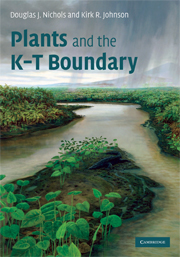10 - Assessment of the K–T boundary event
Published online by Cambridge University Press: 22 August 2009
Summary
In this book we have attempted to provide an overview of the state of knowledge of plants and the K–T boundary. The center of North America has yielded a rich floral record and the high quality and vast extent of exposures hold much promise for further refinement. Nearly all of the K–T boundary sections that contain evidence of the impact event are in North America. For this reason, it is difficult to make global generalizations other than to say that more sections are needed on other continents. In fact, it is fair to say that without the North American record, we would be hard pressed to argue for major floral change at the K–T boundary. Only the New Zealand sections document floral change relative to the iridium anomaly, and in those sections it is primarily the fern-spore spike that supports the concept of an impact as a causal mechanism. Were the New Zealand sections studied in isolation, it is questionable whether the fern-spore spike would have been recognized as significant. Only when taken in context of the North American fern-spore spike is the New Zealand occurrence interpretable. Nonetheless, its presence and close association with an iridium spike is one of the strongest arguments for the global reach of the immediate and deleterious effects of the bolide impact. The loss of forest canopy at the K–T boundary in New Zealand was followed by the nearly complete recovery of the pre-existing Cretaceous forest.
- Type
- Chapter
- Information
- Plants and the K-T Boundary , pp. 217 - 221Publisher: Cambridge University PressPrint publication year: 2008

